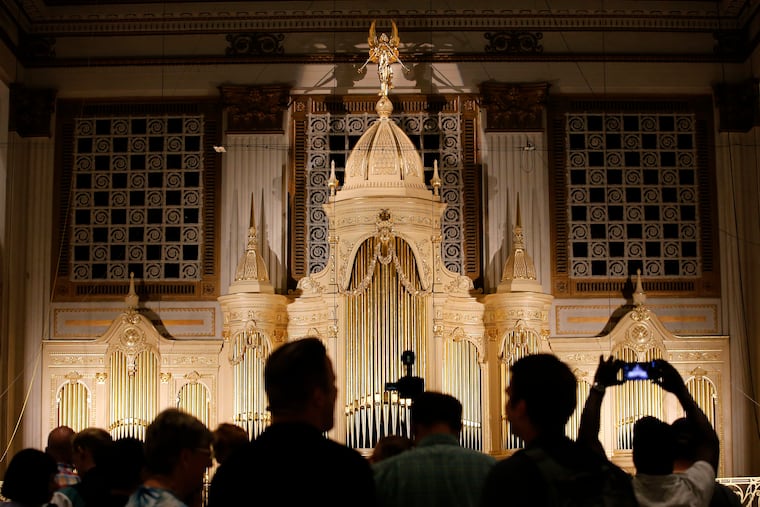
Late Saturday morning a two-story-tall black drape dropped dramatically at the Center City Macy’s store and revealed the newly renovated case for the famous Wanamaker Organ.
It was painted a warm creamy color and trimmed with gold — real gold — leaf. The golden angel on top was resplendent.
The crowd cheered, listened to some speeches, and was treated to a surprise rendition of the “Hallelujah Chorus,” delivered by a 250-person “flash choir,” said Paul Marchesano, an organ enthusiast who was among the singers.
That’s a lot of hoopla for parts of the organ that are purely cosmetic, a little like cheering a great opera singer for her new dress. But shoppers accurately pronounced the new case “beautiful” and “gorgeous.”
Like many a home improvement project, the gleaming new paint and gold made some of the surrounding walls look a little drab by comparison, but that’s an even bigger job.
The unveiling was part of the celebration of the 26th annual Wanamaker Organ Day, an event that included several concerts. The organ, the largest operating musical instrument in the world, was installed in 1911.
Ray Biswanger, executive director of Friends of the Wanamaker Organ, said he had been hoping for a face-lift of the “pretty battered” case and pipes for years. About a year ago, he broached the idea with Macy’s, and they jumped on it. He said they saw the organ as a way to provide a “vibrant and dazzling” shopping experience.
He got estimates and Macy’s agreed to split the cost with Biswanger’s group, which got a grant from the Wyncote Foundation. Asked how big the bill was, he said: “Macy’s doesn’t like to reveal that.” He did say that the project required 3.5 pounds of real gold, which currently costs $1,300 an ounce. We’ll do the math for you: That’s $72,800 for just the gold.
Biswanger was ecstatic about the results. “It just exceeded our wildest imaginings,” he said.
“We think people will be stunned by it. It’s so gorgeous. We call that the most-looked-at wall in Philadelphia.”
The Brooklyn-based restoration company EverGreene Architectural Arts completed the organ case project, which was overseen by Cory Michael. His crew’s first job was to reveal the history of past paint campaigns (that’s restoration lingo for each layer of paint) on the 60-by-45-foot case, and to discover whether the pipes and angel were covered with real or fake gold.
The gold was real and the conservators found that there had been three previous paintings, the last of which was at least 30 years ago. (Biswanger thinks it was more than 50.)
Michael described the most recent paint as “sort of a yellowish green tone” that was showing its age. The original paint was a light gray. Team members decided that neither worked best with current surroundings and instead went with warmer tones. They picked a creamy off-white base and topped it with a sienna (a rusty color) glaze.
The paint was sprayed on. The gold leaf was another matter entirely.
First, the team had to fill cracks and holes so that surfaces were smooth. Then, gilders applied sheets of gold so fragile and thin that a breath can make them disintegrate.
The leaf arrives packed between layers of paper. For ornate areas, gilders used sheets that were 3⅜ inches square. For bigger, smoother areas like the 117 pipes, the gold leaf came from narrow 20-foot rolls.
The leaf is laid onto a layer of glue, then burnished with a gilder’s tip, a brush made from squirrel hair. Yes, squirrel hair. “It’s the softest brush that you can use,” Michael said.
As you can imagine, applying the leaf, he said, is “very tedious work.”
Michael got to see the work in its entirety for the first time Saturday. “It’s magnificent,” he said. “It really is.”